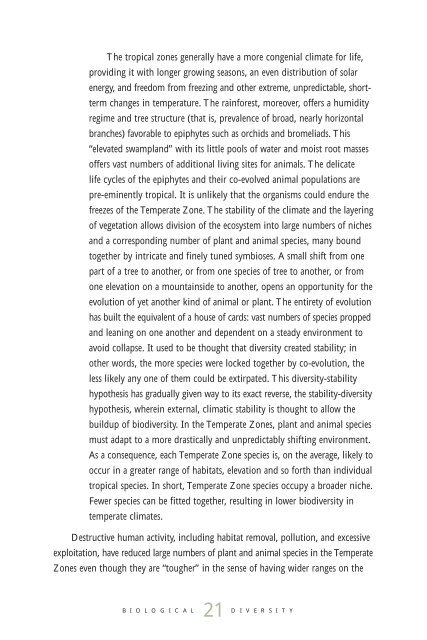Download Biological Diversity - New York State Museum
Download Biological Diversity - New York State Museum
Download Biological Diversity - New York State Museum
Create successful ePaper yourself
Turn your PDF publications into a flip-book with our unique Google optimized e-Paper software.
The tropical zones generally have a more congenial climate for life,<br />
providing it with longer growing seasons, an even distribution of solar<br />
energy, and freedom from freezing and other extreme, unpredictable, shortterm<br />
changes in temperature. The rainforest, moreover, offers a humidity<br />
regime and tree structure (that is, prevalence of broad, nearly horizontal<br />
branches) favorable to epiphytes such as orchids and bromeliads. This<br />
“elevated swampland” with its little pools of water and moist root masses<br />
offers vast numbers of additional living sites for animals. The delicate<br />
life cycles of the epiphytes and their co-evolved animal populations are<br />
pre-eminently tropical. It is unlikely that the organisms could endure the<br />
freezes of the Temperate Zone. The stability of the climate and the layering<br />
of vegetation allows division of the ecosystem into large numbers of niches<br />
and a corresponding number of plant and animal species, many bound<br />
together by intricate and finely tuned symbioses. A small shift from one<br />
part of a tree to another, or from one species of tree to another, or from<br />
one elevation on a mountainside to another, opens an opportunity for the<br />
evolution of yet another kind of animal or plant. The entirety of evolution<br />
has built the equivalent of a house of cards: vast numbers of species propped<br />
and leaning on one another and dependent on a steady environment to<br />
avoid collapse. It used to be thought that diversity created stability; in<br />
other words, the more species were locked together by co-evolution, the<br />
less likely any one of them could be extirpated. This diversity-stability<br />
hypothesis has gradually given way to its exact reverse, the stability-diversity<br />
hypothesis, wherein external, climatic stability is thought to allow the<br />
buildup of biodiversity. In the Temperate Zones, plant and animal species<br />
must adapt to a more drastically and unpredictably shifting environment.<br />
As a consequence, each Temperate Zone species is, on the average, likely to<br />
occur in a greater range of habitats, elevation and so forth than individual<br />
tropical species. In short, Temperate Zone species occupy a broader niche.<br />
Fewer species can be fitted together, resulting in lower biodiversity in<br />
temperate climates.<br />
Destructive human activity, including habitat removal, pollution, and excessive<br />
exploitation, have reduced large numbers of plant and animal species in the Temperate<br />
Zones even though they are “tougher” in the sense of having wider ranges on the<br />
B i o l o g i c a l<br />
21 D i v e r s i t y
















